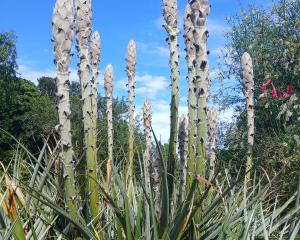Many common vegetables are descendants of coastal plants, which is why adding seaweed to the vegetable plot has much to commend it, Gillian Vine suggests.
If you can get it, seaweed is an excellent addition to the compost bin.
Apart from costing nothing, there is a good reason for using seaweed. Most compost is used to ginger up the vegetable garden and because many of our vegetables originate from seaside plants, adding seaweed to the mix makes sense.
New Zealand spinach (Tetragonia tetragonioides) and wild celery (Apium australe) grow along our coastlines and although the latter is more often used as a decorative plant, it has been eaten.
It has also been argued wild celery was the "scurvy grass" Captain James Cook forced his hapless sailors to eat.
Most of our vegetables originate in the northern hemisphere, though, and the descendants of wild cabbage, beets, turnips, celery and asparagus still like a taste of what their ancestors thrived on.
Wild cabbage (Brassica oleracea ssp. oleracea) was probably taken to Britain by the Romans some 2000 years ago, or possibly the Saxons 400 years later.
It certainly caught on and Napoleon is sometimes given credit for saying: "The English have only three vegetables and two of them are cabbage".
That may not be too far from the truth because the three types of cabbage - smooth-leafed, savoy and red-leafed - some kales, Brussels sprouts, broccoli, kohl rabi, mustard and cauliflower all have been developed from B. oleracea.
Each brassica breeds true but quickly reverts to type if crossed with another group, which is why commercial seed growers keep their brassicas segregated and why - leaving aside the fact that hybrids don't usually breed true - saving seed at home is something of a lottery.
Globe artichokes (Cyanara cardunculus) are a cultivated version of the cardoon, grown around the Mediterranean Sea for its edible stalks.
Artichokes are grown for their edible flower heads, eaten while they are immature.
If the fiddly nature of eating artichokes does not do much for you, they are handsome, thistle-like plants that can reach 2m. Cardoons can grow to 3m in height.
The Jerusalem artichoke is quite different, being a perennial sunflower from inland North America.
Celery and celeriac descended from one plant that liked to grow near the sea, as did parsley; but the carrot, a member of the same family, probably originated in Central Asia, a long way from the coast.
Wild sea beet (Beta vulgaris ssp. maritima) grows on the temperate coastlines of Europe and western Asia. It was first cultivated for its leaves, from which we now have silverbeet, and much later for its swollen roots (beetroot and sugar beet).
Sea kale's Latin name, Crambe maritima, gives a hint as to its origins. Native to the Black Sea region, this cabbage-like vegetable grows wild on the English and Irish coasts, and in bygone days locals heaped shingle around plants to blanch the stems.
It became very popular in England in the early 19th century when that great gourmand, the corpulent Prince Regent, had sea kale served at the Royal Pavilion, in Brighton.
Sea kale can be grown from seed but can be a bit of a challenge to get started, as germination tends to be erratic.
It is worth persevering, for - unlike cabbage, cauliflower and the like, which are annuals - sea kale is a perennial that can be cropped year after year. It is better left until the second season to start cropping.
When the tips of the new shoots start poking through the soil in spring, cover them with a flower pot (plug the drainage hole to keep out any light) and when the sea kale stems are about 20cm long, snap them off and head for the kitchen.
The shoots are served like asparagus, with either a béchamel sauce or melted butter.
Asparagus is another perennial vegetable with a penchant for the seaside. Although its exact origins are unknown, by about 200BC Roman Marcus Cato was sufficiently enamoured by asparagus to claim it was the only vegetable, apart from cabbage, worth eating.
Other Italians obviously enjoyed the tasty spears, as asparagus found its way to every corner of the Roman Empire, including England, where it was an esteemed addition to the tables of the wealthy in the time of Elizabeth I.
By the end of the 18th century, the southwestern London suburbs of Battersea and Mortlake were prime market garden areas, with asparagus the principal crop.
For those interested in growing their own, asparagus plants (crowns), usually two years old, can be bought in garden centres.
They are planted while dormant and will yield a few spears the first season and more over the years as the plants' underground rhizomes develop. Asparagus can also be grown from seed.
Mary Washington is a popular old variety, while Sweet Purple has, as the name indicates, purplish stems.
Like sea kale, asparagus seed can be slow to germinate and there is a wait until the plants are mature enough to begin cutting.
But growing from seed is a much less expensive way to get started.
The good thing about home-grown asparagus, apart from the flavour, is that a bed will last 15 years or more, so it justifies the initial effort.
So toss some seaweed on the compost bin, add a layer of green weeds or soil, then put on a cover and leave it to cook over winter.
Your vegetables with a seaside heritage will love you for it.












